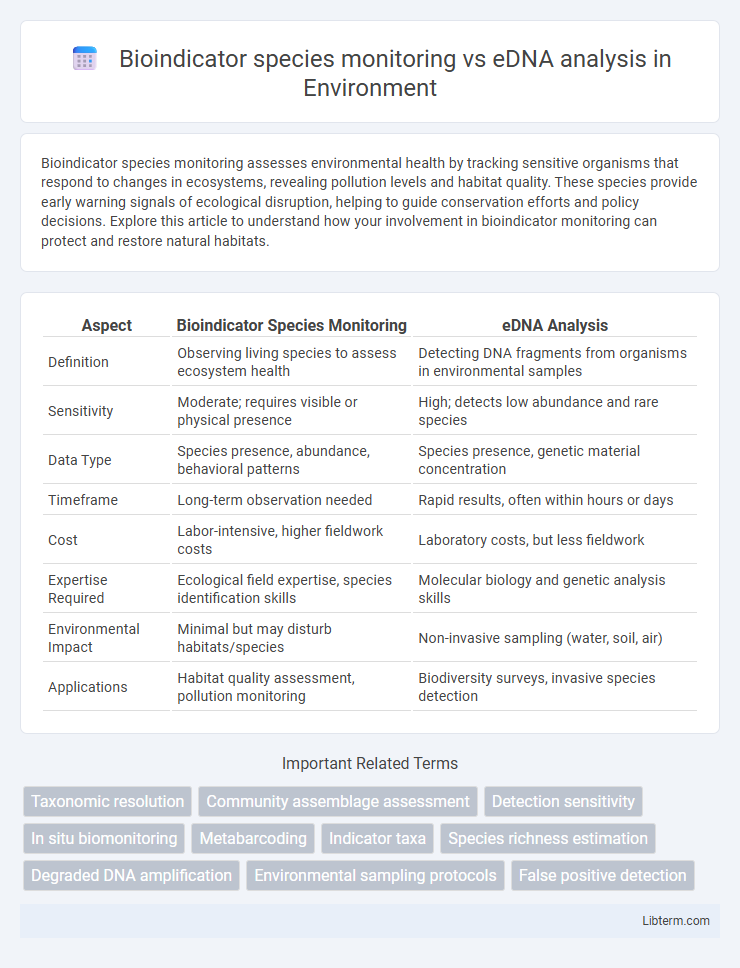Bioindicator species monitoring assesses environmental health by tracking sensitive organisms that respond to changes in ecosystems, revealing pollution levels and habitat quality. These species provide early warning signals of ecological disruption, helping to guide conservation efforts and policy decisions. Explore this article to understand how your involvement in bioindicator monitoring can protect and restore natural habitats.
Table of Comparison
| Aspect | Bioindicator Species Monitoring | eDNA Analysis |
|---|---|---|
| Definition | Observing living species to assess ecosystem health | Detecting DNA fragments from organisms in environmental samples |
| Sensitivity | Moderate; requires visible or physical presence | High; detects low abundance and rare species |
| Data Type | Species presence, abundance, behavioral patterns | Species presence, genetic material concentration |
| Timeframe | Long-term observation needed | Rapid results, often within hours or days |
| Cost | Labor-intensive, higher fieldwork costs | Laboratory costs, but less fieldwork |
| Expertise Required | Ecological field expertise, species identification skills | Molecular biology and genetic analysis skills |
| Environmental Impact | Minimal but may disturb habitats/species | Non-invasive sampling (water, soil, air) |
| Applications | Habitat quality assessment, pollution monitoring | Biodiversity surveys, invasive species detection |
Introduction to Bioindicator Species Monitoring
Bioindicator species monitoring involves observing organisms such as amphibians, lichens, or freshwater invertebrates to assess environmental health and detect pollution levels. These species respond to changes in air, water, or soil quality, providing tangible ecological data over time. This traditional method offers direct, species-specific insights into ecosystem conditions and long-term environmental trends.
Understanding Environmental DNA (eDNA) Analysis
Environmental DNA (eDNA) analysis enables the detection of aquatic and terrestrial species by capturing genetic material shed into the environment, providing a non-invasive, highly sensitive method for biodiversity monitoring. Unlike traditional bioindicator species monitoring, which relies on direct observation or capture of organisms, eDNA analysis offers rapid assessment of species presence, even at low population densities. This molecular approach significantly enhances ecological surveys, supports early detection of invasive species, and aids in conservation management by revealing detailed insights into ecosystem health.
Key Differences Between Bioindicator Monitoring and eDNA Analysis
Bioindicator species monitoring relies on observing specific organisms whose presence or condition reflects environmental health, providing direct ecological context through field surveys and species behavior assessment. eDNA analysis detects genetic material shed by organisms into the environment, offering rapid, non-invasive identification of multiple species simultaneously, including elusive or low-abundance taxa. Key differences include bioindicators' requirement for expert taxonomic knowledge and tangible organism encounters versus eDNA's high sensitivity, broad biodiversity detection, and potential challenges in interpreting DNA persistence and contamination risks.
Methodologies Used in Bioindicator Species Monitoring
Bioindicator species monitoring primarily employs direct observation, physical sampling, and population assessments to gauge ecosystem health based on species presence, abundance, and behavior. Techniques include transect surveys, quadrat sampling, and capture-mark-recapture methods to collect data on indicator species sensitive to environmental changes. These methodologies enable detailed, species-specific insights but often require considerable field effort and taxonomic expertise compared to eDNA analysis.
eDNA Sampling and Analysis Techniques
eDNA sampling involves collecting environmental samples such as water, soil, or sediment to detect trace amounts of genetic material shed by organisms, providing a non-invasive method for biodiversity assessment. Advanced analysis techniques like quantitative PCR (qPCR) and next-generation sequencing (NGS) enable precise identification of species presence, abundance, and distribution based on DNA fragments. Compared to traditional bioindicator species monitoring, eDNA methods offer higher sensitivity and faster detection of elusive or low-density species, enhancing ecosystem monitoring efficiency.
Advantages of Bioindicator Species Monitoring
Bioindicator species monitoring provides direct, real-time insights into ecosystem health by observing species that respond specifically to environmental changes, making it reliable for detecting pollution and habitat degradation. This method allows for long-term trend analysis through established bioindicator species with known ecological ranges and sensitivities. Field observations offer context-rich data on species behavior, population dynamics, and community interactions that eDNA analysis alone cannot capture.
Benefits and Limitations of eDNA Analysis
Environmental DNA (eDNA) analysis offers non-invasive, rapid detection of species presence with high sensitivity, enabling monitoring of aquatic and terrestrial biodiversity without direct organism sampling. However, eDNA methods face limitations such as difficulties in quantifying population abundance, potential contamination risks, and challenges in distinguishing closely related species due to overlapping genetic markers. Despite these constraints, eDNA complements traditional bioindicator species monitoring by providing a cost-effective and comprehensive approach to ecosystem health assessment.
Case Studies: Bioindicator Monitoring vs eDNA in Action
Case studies comparing bioindicator species monitoring and eDNA analysis reveal distinct advantages in ecosystem assessment. For instance, bioindicator monitoring in freshwater streams has provided long-term data on pollution impacts through macroinvertebrate populations, while eDNA analysis in the same environments rapidly detects rare or elusive species with high sensitivity. Such comparative studies illustrate how integrating bioindicator data with eDNA results enhances biodiversity assessment accuracy and supports more informed conservation strategies.
Integrating Bioindicator Data and eDNA for Ecosystem Assessment
Integrating bioindicator species monitoring with environmental DNA (eDNA) analysis enhances ecosystem assessment by combining direct species observations with molecular detection methods, providing a comprehensive understanding of biodiversity and ecological health. Bioindicator data offer long-term, species-specific insights into environmental conditions, while eDNA enables rapid, non-invasive detection of multiple taxa, including elusive or low-abundance species. This integrated approach improves the accuracy of ecosystem monitoring, supports early detection of environmental changes, and informs conservation strategies through complementary and corroborative data streams.
Future Prospects and Innovations in Environmental Monitoring
Bioindicator species monitoring remains a vital method for assessing ecosystem health due to its direct reflection of biological responses to environmental changes. Emerging technologies in eDNA analysis offer high sensitivity and rapid detection of biodiversity by analyzing genetic material in environmental samples, enabling early identification of invasive or endangered species. Future innovations will likely integrate eDNA techniques with bioindicator data, enhancing real-time monitoring capabilities and providing comprehensive, scalable solutions for ecosystem management and conservation efforts.
Bioindicator species monitoring Infographic

 libterm.com
libterm.com